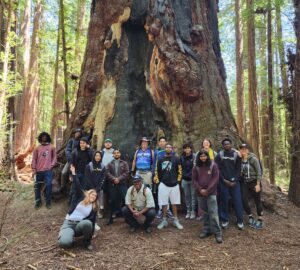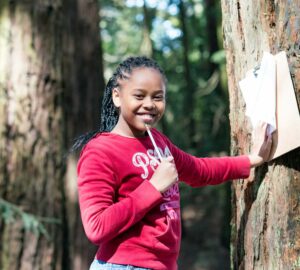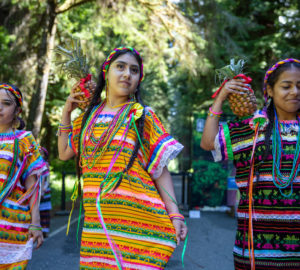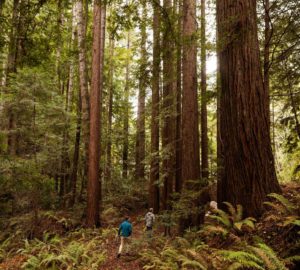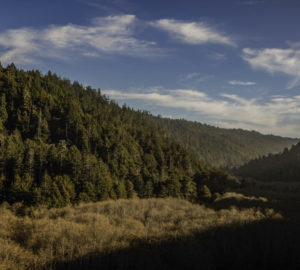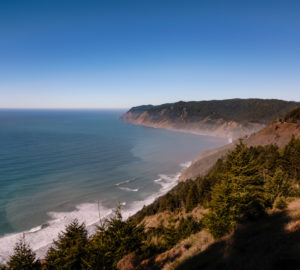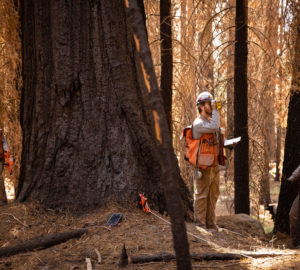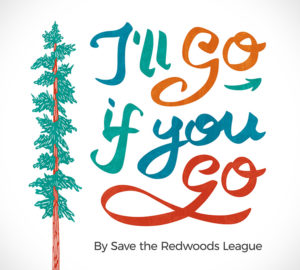The following is an edited version of a speech delivered at an event in San Francisco on Jan. 30, 2020, announcing the public phase of Forever Forest: The Campaign for the Redwoods.
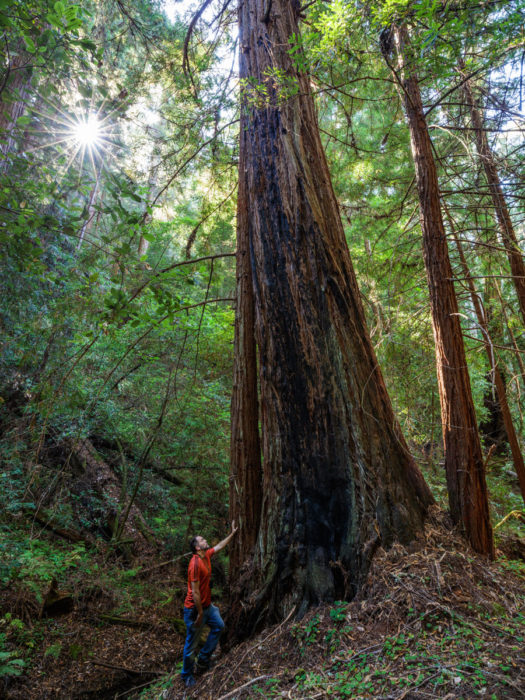
But as we know too well, these old-growth groves, and the dozens of others that we and our partners have protected, are the exception. They are isolated islands, the last remaining examples of the giant forest that used to cover 350 miles of the California coast. Those islands represent just 5 percent of that original forest.
The coast redwood forest today is dominated by a sea of young redwoods surrounding the last of the old-growth redwoods across more than a million acres of private commercial forest land.
That forest of young trees sprouting from ancient roots, that sea of potential that surrounds our islands of protected wildness—that is the conservation opportunity of our generation, the old growth of the future – the forever forest.
If the old-growth of the Founders Grove helps to tell the story of our first 100 years, the second century of saving the redwoods will be better reflected in a redwood forest of a different sort.
The Wonder Plot
A few miles up Big River from Mendocino, on state park land on the ancestral territory of the Mitom Pomo tribes, there’s a forest plot that was clear-cut in the mid-1800s. In the 1920s, a University of California, Berkeley, forestry professor named Emanuel Fritz started measuring the forest’s growth to assess the regeneration of redwoods. He remeasured the plot every decade for 60 years, and by the 1960s, the forest was already showing characteristics of an old-growth grove.
He made this observation:
“To stand in this … forest is to make one wonder over the power of nature – the rain, the sun, the soil – to heal a wound. This young forest lacks the majesty of the climax forest of redwoods which it has replaced and which, in time, it will duplicate and, quite possibly excel in grandeur. But the young forest exemplifies the spirit of youth, the urge to grow bigger & stronger.”
Fritz became one of the League’s longest serving Councilors, his tenure running over 50 years. Today his work lives on under the League’s Redwoods and Climate Change Initiative as we continue his record of redwood measurements. What we are learning in this second-growth forest is truly extraordinary. Already, the leaf surface area in this grove is breaking records.
These young trees are over 250 feet tall. This young grove has already accumulated more biomass, and therefore carbon storage, than nearly any forest ever measured.
This small sample of second-growth redwoods – now known as the Fritz Wonder Plot – tells a story of recovery and healing, of opportunity and potential, and of resilience.
We now know that a logged forest has the potential to recover within a human lifetime—now imagine if we could leverage our knowledge across the redwood range.
Many of us have walked through young redwood forests like what Fritz described. The Forest of Nisene Marks, Arcata Community Forest, or Reinhardt Redwood Regional Park in Oakland.
The Young Forests
I have spent so much time in Reinhardt Redwood Regional Park that it sometimes feels like I raised my kids in that forest. And when we chased each other along the trails and built lean-tos out of fallen limbs, I talked with them about the superpowers of the redwoods, most importantly, their resilience; their determination to bounce back after something goes wrong.
When people first built the cities of Berkeley, Oakland, and San Francisco, they cut down every redwood tree in these hills.
I told my sons how the people who lived here back in the 1930s, when times were really hard, decided to save this place so that these trees could grow old again. And now the fish are back in redwood creek. The trees are so big that all four of my sons can barely get their arms around them.
This forest helps all of us—the thousands of people who walk these trails every week, visitors as diverse and vibrant as the City of Oakland in which it grows. The forest helps us feel a part of nature coming back.
The young redwoods offer hope; a path to something better, an opportunity to be part of a solution and help nature find its balance. This shows the power of nature to heal a wound, the spirit of youth in the young forest.
For all of our focus on old-growth redwoods, most of the redwoods trying to grow back in California today are very young.
Over the past 150 years, most of the redwood forest has been cut over three or even four times. But we know now how quickly these forests can regenerate, how with time and stewardship they can recover the habitat, the fire resilience, the stable carbon storage, and the cathedral-like beauty that we need now more than ever. And there are over 1 million acres of young redwood forest poised for that recovery.
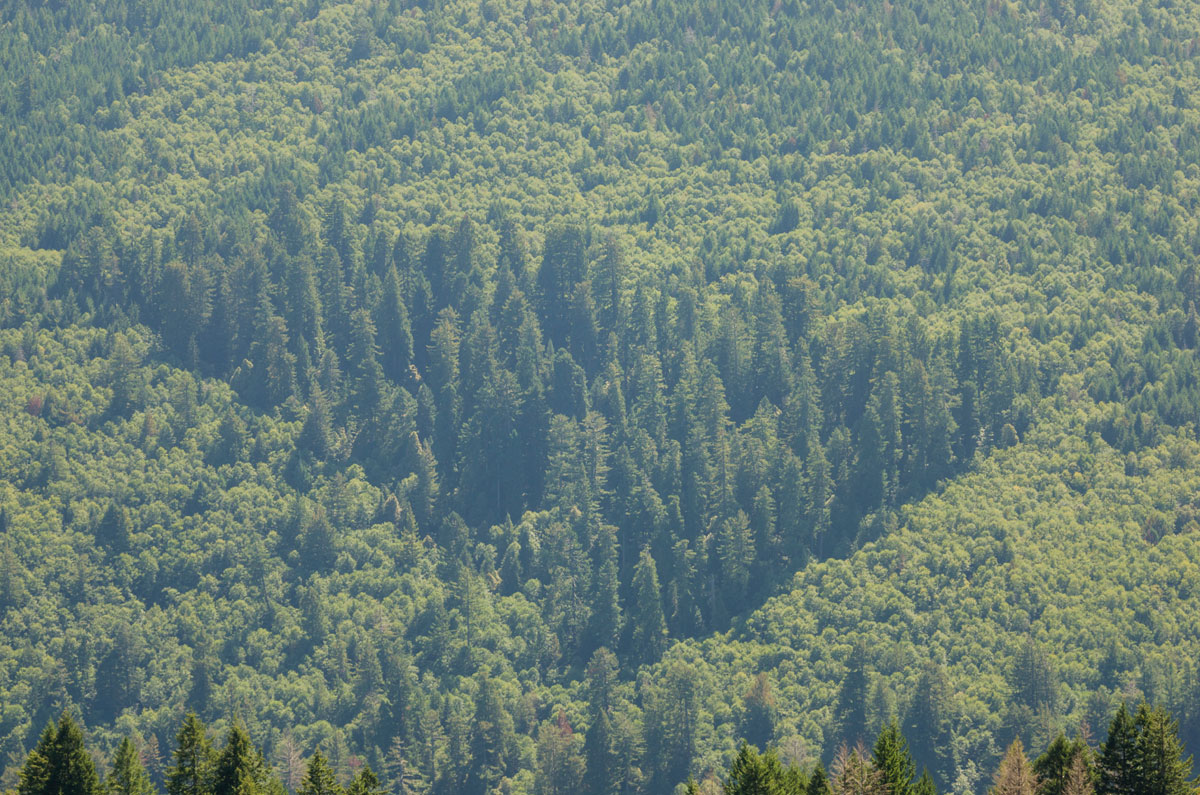
A New Direction
Now we will begin to heal our forever forest. This is the pivotal moment where we embark on this journey, when our generation turns the tide and changes the trajectory of the redwood forest. We’re shifting from defense to offense. Having led in the effort to save the last of the old-growth forests, today, we lead by growing the forest back. And this means restoring a contiguous landscape of healthy coast redwood forests across their ancient range and restoring the natural function of the giant sequoia forest.
The League’s Forever Forest Campaign will:
- Accelerate the pace and scale of our land conservation in the redwoods;
- Restore whole landscapes of young redwood forests so they become the old-growth forests of the future;
- Reimagine our parks to inspire a new generation with the beauty and power of nature.
Protecting Our Redwoods
What do we mean by accelerating the pace and scale of land conservation in the redwood forest?
The early successes funded by the Forever Forest Campaign tell it best. Most recently, there was Alder Creek, 530 acres of ancient giant sequoia forest, a crucial missing piece of Giant Sequoia National Monument, and a landscape of indescribable beauty. This came right on the heels of the League’s acquisition of the Red Hill property – the second largest unprotected giant sequoia grove after Alder. We also protected Harold Richardson Redwoods Reserve in Sonoma County which, at 730 acres, was the largest unprotected old-growth coast redwood grove left.
Building on these successes, the League has announced a new conservation opportunity. We have negotiated an agreement to purchase the 564-acre Cascade Creek, a critical missing puzzle piece in the protected redwood forest of the Santa Cruz Mountains.
As we finish the work of protecting the last of the remaining old-growth forest, the work of landscape-scale conservation begins. That means going big to protect the expansive young redwood forests that surround and sustain that remaining old-growth forests. This means:
- Purchasing young redwood forests at scale to remove the threat of further commercial harvest, and setting them on a restoration trajectory to grow old again; and
- Securing conservation easements on working forests, partnering with private landowners to keep forests intact and managed to the highest ecological standards.
Restoration
While the acquisition removes the threat, restoration accelerates the healing of the forest.
Back in 2002, the League secured the expansive 25,000-acre Mill Creek property and added it to Redwood National and State Parks, setting in motion a restoration vision that would become the future of redwoods conservation.
With that young recovering forest out of harm’s way, we launched the most ambitious restoration project ever considered in the redwood forest: Redwoods Rising. With funds raised through the Forever Forest Campaign, combined with public funding from our state and federal partners, we’re restoring 10,000 acres of young redwood forests over the next five years.
Our restoration treatments of these redwood stands will accelerate the return of old-growth habitat, carbon storage, and fire resilience. We are decommissioning mile after mile of abandoned logging roads, and planting thousands of trees to re-wild these scarred forests.
In a landscape marred by recent generations of industrial forest management, we will be learning from and engaging the native communities who have been stewarding these forests for thousands of years.
Similarly, in the giant sequoia range, we have learned of the unprecedented threats of catastrophic wildfire as a result of poor forest management. Because natural fires have been suppressed for generations and fire seasons are getting hotter and longer, the giant sequoia forests are in extreme need of restoration stewardship.
We restore these forests not just because of their ability to store carbon, or because of the species that rely on the habitat they provide. And not only to build resilience back into our coastal and Sierra landscapes, and right the wrongs of displacement and destruction in a landscape millions of years in the making. We do it for all these reasons, but also because the world is watching. Because 31 million people come to visit California’s redwood parks every year to be inspired. We need the world to witness how the people of California choose to steward our once and future forest. This is how we amplify our restoration vision. This is how we lead. This is how we change the world.
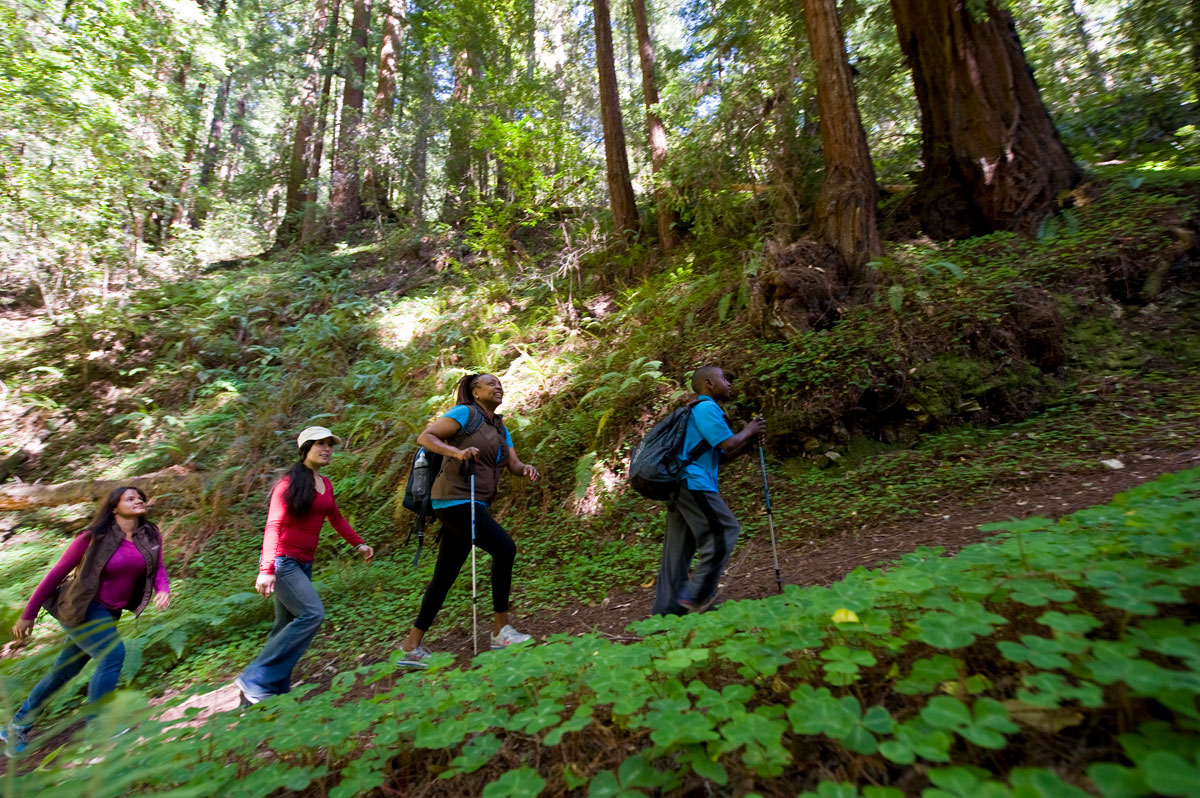
Connecting to the New California
About those 31 million visitors. Save the Redwoods League created a redwood park system both for the sake of the forest, and because parks make our lives better, our communities stronger and families healthier. From our earliest days, our conservation mission has been as much about people as about forests.
Many of the state’s redwood parks were designed and built when California had a population of 5 million people. Today we are pushing 40 million with cultural and ethnic diversity never considered when the parks were created.
Today, we can reimagine our parks to inspire a new generation of visitors by engaging the communities that were excluded in the past, by inviting underrepresented audiences to lead in the process of healing the forests and building the parks of the future.
Last year, I took a hike in the League’s Harold Richardson Redwoods Reserve that I will never forget.
Through the generosity of our donors to this campaign, we acquired this hidden gem of ancient redwoods in the remote hills of the Kashia band of the Pomo in Sonoma County. We are in the process of planning for how to open that extraordinary forest to the public in what will be one of the first new old-growth redwood parks in a generation.
Teresa Baker, a community leader who advocates for diversity in the outdoors, worked with us to invite a group of more than a dozen outdoor recreation leaders from all over the country to be the first to experience this extraordinary place. For several hours we walked among trees that have stood since the Roman Empire, staring into the canopy, studying understory plants, dissecting owl pellets, gasping at the light filtering through the green, literally hugging trees as we went.
Down the trail, we wandered into a gigantic fairy ring, big enough for all of us to sit on the soft bed of needles on the forest floor, in the footprint of a fallen giant, encircled by tall redwoods that sprouted from the original tree hundreds of years ago. It was a magical gathering place, and it inspired a powerful conversation.
As thru-hikers, Outward Bound leaders, rangers, climbers, surfers, environmental activists, and storytellers, none of these adventurers were strangers to the outdoors, and all saw the importance of these places in building community, hope, and trust. We talked about how the complex redwood root system holding the forest together is a metaphor for our own communities—how we are all connected with one another and our environment.
It crystallized the importance of engaging new voices and new audiences as we heal our shared forest and transform our parks to be welcoming and valuable to everyone.
With the Forever Forest Campaign, we can lead in this work. We have new redwood parks to design and open to the public like Harold Richardson, or Alder Creek, where the diverse communities of the Central Valley are within a two-hour drive. We are reimagining redwood park interpretation to speak to the communities that have historically not engaged in the redwood parks.
We will create redwood destinations for the visitors who need them. We have the opportunity to rebuild the visitor center at Redwood National and State Parks. We have supported the development of a conceptual design for a world-class recreation and education destination at the southern gateway to Redwood National and State Parks, a UNESCO World Heritage Site. The League is working closely with its public partners to secure the state and federal funds required to realize this shared vision.
This facility will welcome the world to the tallest forest on Earth, the largest concentration of ancient redwoods remaining – and the most ambitious redwood forest restoration project ever undertaken.
Building the Forever Forest
What legacy will we leave behind? Let it be a redwood forest of the scale and grandeur that once graced the California coast and Sierra Nevada. Let it be a forever forest.
Our Campaign for the Redwoods calls on everyone to come together to set that vision into motion. We need a movement to help us secure the future of the redwoods by funding some of the most ambitious land acquisitions, restoration work, and park development projects the League has ever undertaken. Our landscape, our families, and our future are worth the investment. Now is our moment to make a millennium impact. To build something that lasts.
California’s redwood forests—protected forever, restored to grow old again, and connected to all people. That’s how we leave the world better than we found it. And we do it together.

